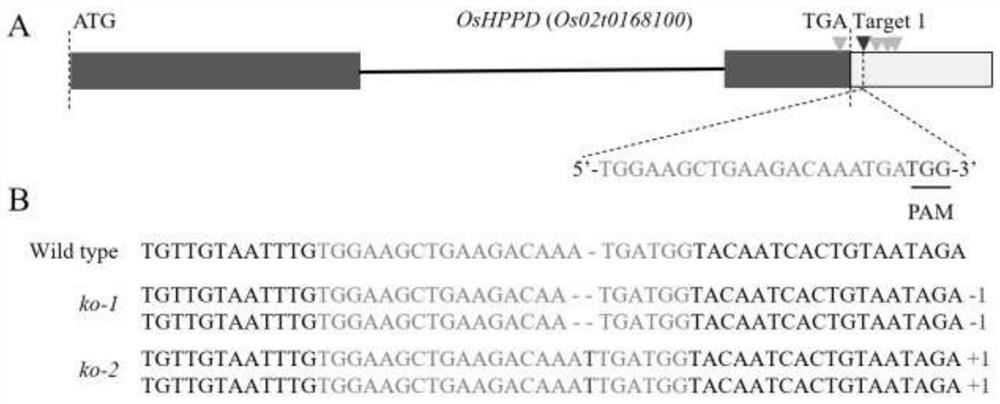Method for improving resistance of rice to HPPD inhibitor herbicides through gene editing, and special sgRNA used therein
A technology of gene editing and transgenic rice, which is applied in the biological field, achieves the effect of obvious tolerance and significant application and promotion value
- Summary
- Abstract
- Description
- Claims
- Application Information
AI Technical Summary
Problems solved by technology
Method used
Image
Examples
Embodiment 1
[0026] Example 1 Gene editing vector construction
[0027]According to the OsHPPD genome sequence, combined with Huazhong Agricultural University CRISPR-P 2.0 (http: / / crispr.hzau.edu.cn / CRISPR2 / ) to design targets and screen out 5 specific sequences with high predicted targeting efficiency and low off-target efficiency. for the generation of sgRNA. The target 1 sequence (SEQ ID NO.6) is located at 309-328 bp of the full-length 451 bp of the second exon of the OsHPPD gene gene (the nucleotide sequence is shown in SEQ ID NO.4). The PAM sequence TGG is located at the 3' end of the target sequence. Other sgRNA target sequences are listed in Table 1. Entrusted Wuhan Boyuan Biotechnology Co., Ltd. to use the CRISPR / Cas9 gene editing system to edit the target gene. The specific operation method refers to the literature Ma et al. Cas9 recombinant vector ( figure 1 ), the recombinant vector contains both the coding gene encoding the specific sgRNA and the coding gene of the Cas9 pr...
Embodiment 2
[0028] Example 2 Obtaining and Identification of OsHPPD Gene Edited Transgenic Plants
[0029] The constructed knockout vector pYLCRISPR / Cas9-OsHPPD plasmid was transformed into the japonica rice recipient variety Yangjing 3012 by using the genetic transformation method mediated by Agrobacterium EHA105. The genetic transformation of rice was entrusted to Wuhan Boyuan Biotechnology Co., Ltd. The general process of transformation is as follows: the pYLCRISPR / Cas9-OsHPPD plasmid was extracted and transformed into Agrobacterium EHA105, and the Agrobacterium EHA105 containing the pYLCRISPR / Cas9-OsHPPD plasmid was used to infect the callus of the japonica rice recipient variety Yangjing 3012, and then transferred to Cultured in the dark at 26°C for 3 days on the co-culture medium, the washed callus was transferred to the selection medium containing hygromycin for resistance selection, and the selected resistant callus was transferred to the pre-differentiation medium for 14 days. T...
Embodiment 3
[0035] Example 3 OsHPPD Gene Editing Transgenic Lines Identification of Herbicide Mesotrione Resistance
[0036] The 2 homozygous gene editing Ts created by target 1 in Example 2 0 Generation plants and other transgenic plants were added to T 2 Homozygous strains were obtained. Will T 2 Rinse the seeds of generation strains and wild-type rice with clean water several times, and use the method of "soaking three times and accelerating one" to soak the seeds for germination acceleration, that is, soak the seeds for three days and accelerate germination for one night. , pay attention to heat preservation during the germination period, and pay attention to temperature control after emergence to prevent seedlings from jumping high. When the seedlings grow to the 2-3 leaf stage, spray the mesotrione suspension. The mesotrione suspension contains 10 μmol / L mesotrione Ketone and 0.02% Tween-20, spray until the blade surface is all wet. After 12 days, check the phenotype of the rele...
PUM
 Login to View More
Login to View More Abstract
Description
Claims
Application Information
 Login to View More
Login to View More - R&D
- Intellectual Property
- Life Sciences
- Materials
- Tech Scout
- Unparalleled Data Quality
- Higher Quality Content
- 60% Fewer Hallucinations
Browse by: Latest US Patents, China's latest patents, Technical Efficacy Thesaurus, Application Domain, Technology Topic, Popular Technical Reports.
© 2025 PatSnap. All rights reserved.Legal|Privacy policy|Modern Slavery Act Transparency Statement|Sitemap|About US| Contact US: help@patsnap.com



